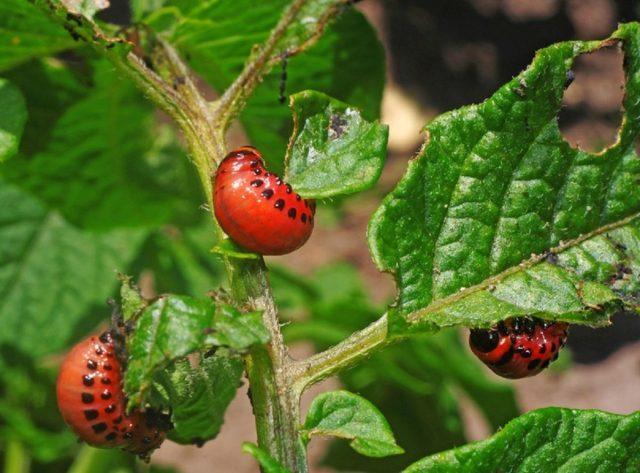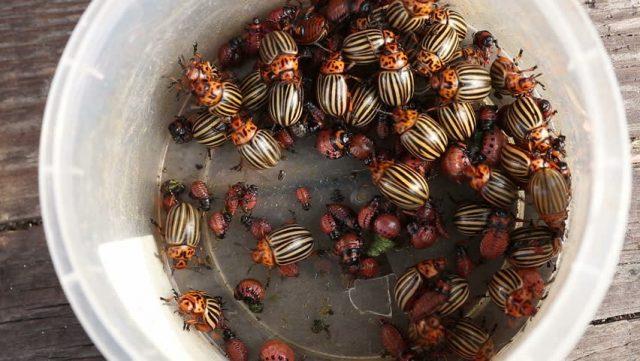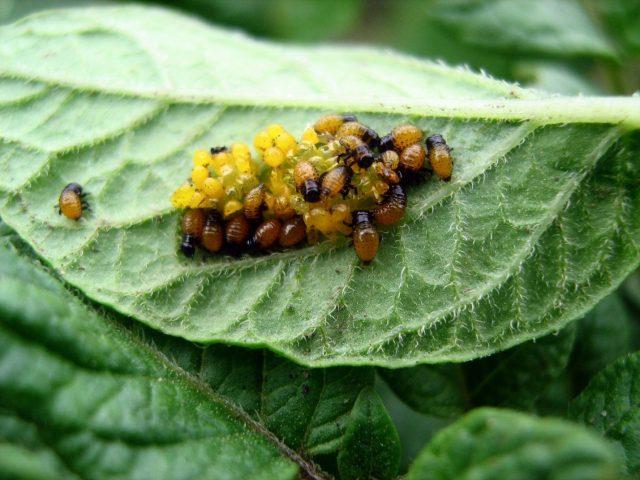Content
The Colorado potato beetle on tomatoes is a nuisance that gardeners who grow this vegetable crop often encounter. The plant bears very tasty and juicy fruits, but requires increased attention and good care. Throughout the season, it needs protection from diseases and insects, among which the most common is the Colorado potato beetle with its numerous offspring.

The Colorado potato beetle is considered one of the most dangerous pests of tomato bushes.
What harm does the Colorado potato beetle cause?
The parasite is a malicious pest that, in particular, attacks crops from the Solanaceae family: tomatoes, potatoes, eggplants, bell peppers. Its appearance on the site causes enormous harm and is fraught with colossal crop losses. The Colorado potato beetle eats tomatoes, adapts perfectly to any environmental conditions, and reproduces very quickly. The gluttony of adult representatives and especially their larvae is so high that they leave behind only eaten plant stems.Insect control is a long and difficult procedure, which includes the use of different methods: folk and chemical means, agricultural techniques.
Signs of defeat
It is not difficult to see that the Colorado potato beetle has attacked the beds with tomatoes, since immediately after its appearance it begins active activity. First of all, its presence is revealed by the eaten edges of the leaves, and if the lesion is extensive, then in just a couple of days the tomato tops can be completely destroyed.
Since the insect is quite large in size, its adults with a body that can reach 12 cm in length are visible to the naked eye. It is easy to distinguish them from other pests by the black stripes on their backs. Almost simultaneously with the appearance of the Colorado potato beetle, a large accumulation of eggs, attached to each other, or already hatched orange-red or yellow larvae can be seen on the back of the tomato leaves.

It is the larvae of the Colorado potato beetle that pose the greatest danger to tomato plantings.
Methods for controlling the Colorado potato beetle on tomatoes
The process of fighting the Colorado potato beetle takes a lot of time. The insect, thanks to the presence of well-developed wings, easily moves over long distances and, having destroyed one bed, immediately flies to another with healthy plants. In just a couple of weeks, striped pests can completely destroy a future harvest.
To get rid of the Colorado potato beetle on tomatoes, it is not enough to treat them with chemicals.It is necessary to use all control methods in combination, including manual collection, folk recipes and biological products.
Manual collection
Collecting the Colorado potato beetle from tomatoes by hand is considered most effective if the number of insects is small or there are few beds in the garden. It will produce a positive result only with constant use.
The method is that the Colorado potato beetle and its larvae are placed in a container filled with water or cuirassier, then tightly closed with a lid. And the eggs, due to the fact that they fit tightly to the leaf and cannot be peeled off, are removed along with the tomato leaf plate and burned.
Some gardeners advise that when the weather warms up, lay out insect bait on the surface of the ground, for which chopped raw potatoes are perfect. When the larvae gather on it, destroy them.

Thanks to the bright colors, pests are easy to spot on the leaves
Attracting insects
In nature, there are insects that help gardeners overcome the Colorado potato beetle and its larvae - these are ground beetles, ladybugs and birds. Attracting these natural enemies to the site can significantly reduce the number of pests in a tomato garden.
Folk remedies
It is quite possible to cope with the Colorado potato beetle using folk remedies prepared on the basis of available and natural ingredients if you can detect the pest at the initial stage of damage to tomatoes. When the number of adults and their larvae is insignificant, the beds are treated with the following solutions:
- From onion skins. Pour vegetable scales (1/2 volume) into a bucket, pour boiling water over them and leave for a day. Then filter, dilute 1:2 with water, and use for spraying tomatoes.
- From laundry soap. A piece of the main component is grated, combined with 100 g of red pepper, poured with a bucket of water, mixed and used to irrigate the bushes.
- Tobacco based. 0.3 kg of tobacco is diluted in 5 liters of water, allowed to brew for a day, and used for spraying.
- From bird droppings. 40 g of chicken manure are diluted in 10 liters of water and the solution is used to water the beds with tomatoes.
- Garlic based. The vegetable heads along with the tops are finely chopped, pour 200 g of raw material into 10 liters of water, leave for 24 hours, add 4 tbsp. l. liquid soap, spray the tomatoes.
- From mustard. Stir 100 g of mustard powder and 100 ml of table vinegar in a bucket of water, add 100 g of soap shavings and mix. The resulting solution is used to treat the above-ground parts of the bushes.
- From wood ash. A kilogram of the component is poured with water, left for a day, 40 g of laundry soap dissolved in boiling water is added, and the plantings are sprayed.
- Urea based. Dissolve 50 g of the product in 5 liters of water and use it to water young seedlings and mature tomato bushes. This composition not only helps destroy colorados, but also serves as a nitrogen fertilizer for plants.

It is better to alternate traditional methods for treating the Colorado potato beetle with insecticide treatment
Chemicals
Indispensable drugs against dangerous insects are chemicals that affect their digestive tract, as well as the nervous system.After literally a single use, they help to completely get rid of both larvae and adult Colorado potato beetles. It is good to spray tomato bushes with those preparations whose effect has been proven over the years. Among these insecticides, the ones that have proven themselves best are:
- Coragen Expert Garden.
- Aktara.
- Bomber.
- Bankol.
- Decis.
- Inta-Vir.
- Karbofos.
- Commander.
The leader of the list is Coragen Expert Garden - a broad-spectrum insecticide that works effectively on nightshades (tomatoes, potatoes, eggplants) against the Colorado potato beetle. Convenient packaging, suitable for use several times. Impact on all stages of pest development (oviposition, larvae, adults). The fact that the product is not washed off by rain is only part of the advantages of Coragen, in addition to its effectiveness, because of which gardeners recommend it for purchase.
Insecticides should be used strictly according to the instructions specified by the manufacturer. Prepare the working solution in accordance with the proportions. It is not allowed to increase the amount of the active substance, as this can harm both tomato bushes and humans. When working with chemicals, you need to wear gloves and other protective equipment.

Chemicals can be used both by irrigating bushes and by embedding them in the ground
Biological products
Biological products are a new generation of insecticidal agents that help destroy the Colorado potato beetle when it first appears.They work due to the fact that they contain special microorganisms that are destructive to the insect, but are ineffective against an increased population. Biological products common among gardeners include Agravertin, Bitoxibacillin and Fitoverm.

Biological products do not accumulate in fruits and are harmless to plant and living organisms
Prevention measures
In order to prevent the appearance of the Colorado potato beetle on tomatoes, or at least try to minimize this risk, it is recommended to take preventive measures. All available methods are used:
- Plant between rows of tomatoes, as well as along the perimeter of the area with repellent plants, which include strong-smelling crops: onions, garlic, nasturtium, peppermint, calendula, coriander, tansy, horseradish.
- Adhere to the rules of crop rotation and change the location of planting tomatoes annually. It is allowed to re-place the crop in the same place only after three years. In addition, it is not recommended to place the crop in beds where other nightshade plants previously grew.
- Pour a handful of wood ash into each hole when planting tomatoes.
- Periodically loosen the beds to destroy the beetle larvae that live in the upper layer of the earth.
- Mulch the beds with straw, since insects that eat the pest's brood develop in it.
- Dust tomato bushes with corn flour, cement, ash or gypsum.
- After harvesting the entire crop, remove tops and other plant debris from the area.
- Dig the soil deeply (40-50 cm) before winter so that the Colorado potato beetle larvae freeze out.
Conclusion
The Colorado potato beetle on tomatoes is one of the most dangerous pests that can cause enormous damage to plantings and future harvests in a very short period of time. This insect is incredibly voracious; it eats up tomato bushes and other nightshade crops almost completely. The fight against the Colorado potato beetle requires an integrated approach and great physical effort. Throughout the season, the gardener should periodically carry out prevention of this pest and begin exterminating it when even single individuals appear.









